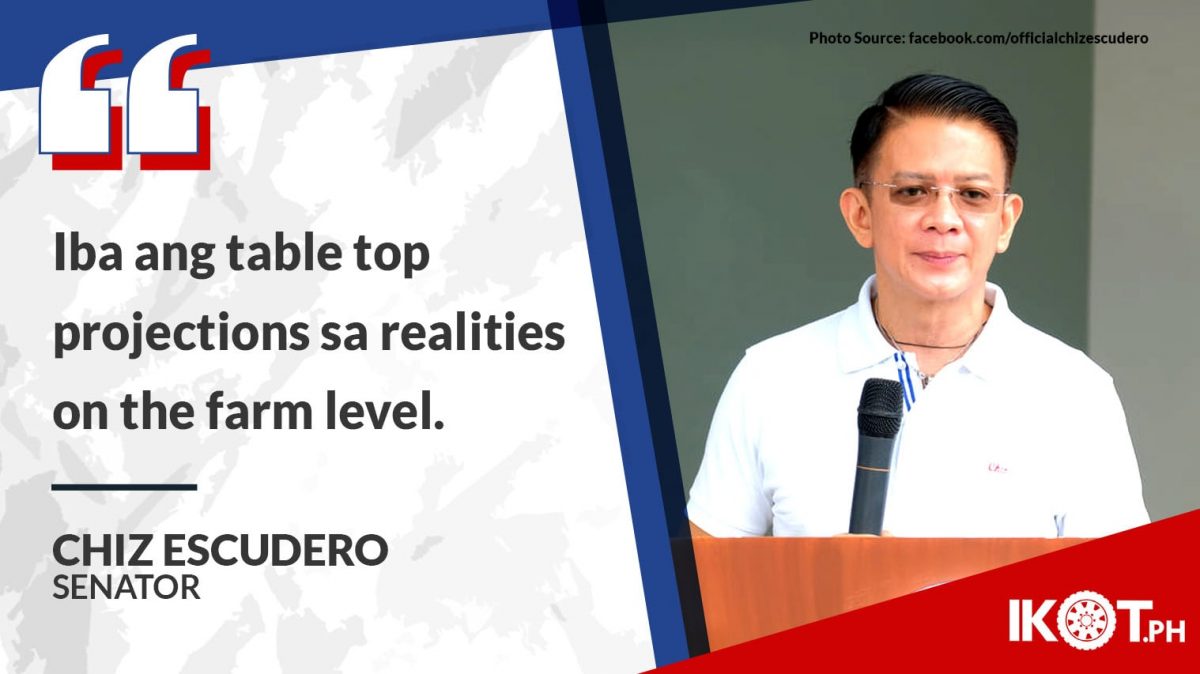Touted by the administration as the “world’s biggest free trade deal,” the Regional Comprehensive Economic Partnership (RCEP) could, however, make the Filipino farmers the biggest losers if the agreement would overpromise but underdeliver like similar laws and treaties in the past.
Senator Chiz Escudero warned that RCEP could end up for farmers as another Rice Tariffication Law (RTL) or a World Trade Organization (WTO) treaty, the potential of which were not maximized and drawbacks were not contained.
While admitting that the free trade deal binding 15 countries would make winners out of some Philippine industries, “it is wrong to market it as some sort of miracle fertilizer that will make Philippine agriculture bloom.”
Escudero proposed that the administration, which has gone on a full-court press to have the RCEP ratified by the Senate, should package a companion measure that will help Philippine agriculture take advantage of RCEP’s benefits and cushion its harm.
The veteran legislator recalled that the RTL included budgetary earmarks that would help farmers weather the entry of cheap rice from abroad.
“Hindi nga ba may Rice Competitiveness Enhancement Fund or RCEF na magmumula sa mga buwis ng imported na bigas ang iniligay sa batas?” the seasoned lawmaker asked.
“Even the country’s formal ascension via a Senate treaty to the WTO almost three decades ago rode on a guarantee that an agriculture and fisheries modernization fund would follow suit as it did. If those agreements had accompanying measures, then why is such missing in what is claimed to be the biggest free trade deal in the world?” the senator pointed out.
Reacting to government claims of windfall benefits the country would reap from RCEP, he said “iba ang table top projections sa realities on the farm level.”
“Sasabihin mo na dahil dito open sesame na ang buong mundo sa mga produktong Pilipino. But wait, before you can export, you have to produce first, hindi ba? Paano ka magpro-produce, wala ngang tubig ang irrigation canal?” Escudero pointed out.
He said the spin that RCEP is the “red carpet to big markets such as a China, Japan, Australia and ASEAN countries is not that simple.”
“Trade is a two-way street.”
“Trade is a two-way street. In their eyes, we are a large customer base of 110 million. So it is actually they who are salivating at the prospects of selling their products here with ease,” Escudero said. “Isa pa iyang durian, na naging poster boy ng RCEP. Saan mo ibebenta at sino kakompetensya? Sa Thailand, Malaysia or Indonesia na pawang durian heavyweights?”
Another assurance from the government is that major Philippine farm produce are excluded from tariff concessions, meaning cuts or abolition.
“The big picture is 1,438 agriculture tariff lines, or about 88 % of total are for elimination, 126 (7%) are for reduction, and 154 (9%) are excluded,” he said.
Escudero noted that the 154 protected products are suffering from low production volume.
“There is nothing in RCEP that can solve this, contrary to the claim that it will result in food security,” he said. “Mula 2018-2020, sa tatlong taon, kasama na ang matumal na 2020 dahil sa COVID-19 pandemic, ang negative trade balance natin sa cereals ay US$ 2.7 billion. Ang sa meat offal o laman loob, tenga at iba ay nasa $1.14 billion.”
“RCEF or not, The government should be investing more funds into agriculture.”
But Escudero said that “RCEF or not,” the government should be investing more funds into agriculture to arrest declining production, tame expensive inputs and improve farmer incomes.
“The best trade deal for farmers is not those that have fancy acronyms but one that would result in farm-level improvements–from new irrigation to good but affordable seeds and fertilizers,” he stressed.
To get the full benefits of RCEP, should the Senate ratify it, Escudero said the government should urgently channel the much-needed financing to the beleaguered farm sector.
“If government is raising capital for the Maharlika Investment Fund which can be invested abroad, then why can’t it package financing for a critical domestic sector? Ang pagkukunan pa nga ng pondo ay ang bangko na ang mandato ay tulungan ang mga magsasaka,” he said.
Escudero was referring to the Land Bank of the Philippines, chartered to help the agriculture sector, but which under the MIF bill is a founding investor with an initial equity of P50 billion.
He said loan portfolios of banks reflect government “risk-averse bias” against lending to farmers but “gung-ho” on the Maharlika Fund that it is being marketed short of a miracle pill.
“For the longest time, we’ve been trying to amend the Charter of Land Bank and the DBP (Development Bank of the Philippines) to tell them you should lend to agriculture and the agriculture sector because the poorest of the poor Filipinos are in that sector,” Escudero emphasized.
“The basic argument of the Bangko Sentral with us in the past 12 years that I’ve been in the Senate before has been ‘no, we cannot allow that. We cannot allow these banks to put 70% of their loanable money in agriculture because it is like putting all their eggs in one basket. If a typhoon hits, if a calamity hits, if disaster hits then the banks might collapse,'” according to him.
“Pero sa Maharlika Investment Fund, willing ang mga regulators at economic managers tumingin sa kabilang banda,” Escudero concluded.


